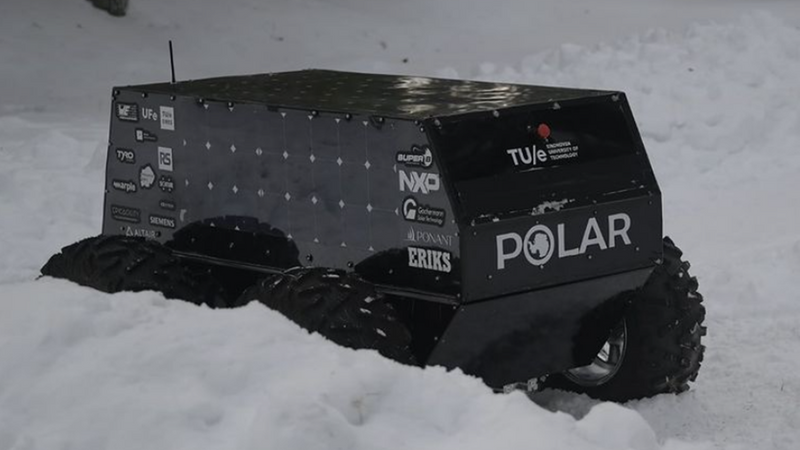Pioneering Autonomous Antarctic Research
Facilitating the human-led and autonomous research in the Antarctic continent.

Who are we?
Team Polar is an Eindhoven-based student team filled with students from different disciplines. Our mission is to facilitate and improve the research going on in Antarctica. We aim to achieve this by building an autonomous, affordable, and electric rover. The reason we go with Antarctica is that the current research going on is led by human-driven vehicles using fossil fuels. Building an autonomous vehicle means it is safer and less expensive since there is no driver to pay.
The Ice Cube
After working for more than a year, Team Polar came up with the Ice Cube. Ice Cube was just the first step towards our vision of building a sustainable and affordable research environment in Antarctica. Ice Cube has 2 square meters of solar panels which helps Ice Cube to go up to 65 kilometers (about half the distance from Washington, D.C. to New York City) per day. With its 28' wheels, the Ice Cube weighs around 350 kilograms (about 771.62 lb).
Progress on Ice Cube
Team Polar is in the second prototype's design process, and the Ice Cube is only used for testing. Since the Ice Cube was built in a short time, some features were missing, such as autonomy. Our software team is using the Ice Cube to test their software and the new sensors that we are aiming to implement on our second prototype. While these tests are being made, new structural components are also being tested. Such as gas springs, hinges, handles, etc. Meanwhile, we are developing a force balance that helps determine possible ranges of mass of the next vehicle. We are also looking into the location of research, which will help determine the driving range and strategy for the energy balance (which will probably be made next year).
Processing REMA Image
Under the “Autonomous Department”, our engineers successfully developed and implemented code to process Reference Elevation Model of Antarctica (REMA) images.
REMA provides the first, high-resolution (2-meter) terrain map of nearly the entire continent. Since each REMA grid point has a timestamp, any past or future point observation of elevation provides a measurement of elevation change.
REMA may provide corrections for a wide range of remote sensing processing activities, such as image orthorectification, and interferometry, and provide constraints for geodynamic and ice flow modeling, mapping of grounding lines, and surface processes. REMA also provides a powerful new resource for field logistics planning.
This is an important step for the autonomy of the Ice Cube. The goal is to calculate the altitudes in Antarctica to find out the clearest and most optimized path for the rover.
The next step for these images is to transform the processed REMA images into a format that is compatible with our A* algorithm.
A* Algorithm
The A* search algorithm is one of the best techniques used in path-finding and graph traversals. The path we derived will be the shortest of all the other options or the most efficient by all parameters considered. A* works by making a lowest-cost path tree from the start node to the target node. What makes A* different and better for many searches is that for each node, A* uses a function f(n) that gives an estimate of the total cost of a path using that node.
The environment of Antarctica and the conditions are the hardest part of our project. We need to come up with innovative and technical solutions. Understanding the altitudes and general geography of Antarctica is crucial.
Furthermore, the design of the rover plays a huge role in our path to success. Our Dynamics Sub team is trying to come up with new ideas for the newest version of the Ice Cube.
Suspension
Unlike the Ice Cube, the new vehicle will use a suspension system. The test in Norway in 2022 showed that; the main purpose of having a suspension is important for keeping all wheels on the ground, for improved traction. Also, it will dampen vibrations to keep the vehicles' most important components as stable as possible.
The suspension system the new vehicle will be using is a so-called double wishbone suspension. For this suspension, every wheel is connected to two-wishbone-shaped arms. Every wheel is independently controlled.
The main advantage of the double-wishbone configuration is its good ratio of kinematic versatility vs. complexity, it being slightly more complex than other systems like the McPherson strut and slightly simpler than others like multi-link suspensions.
Ground pressure
Getting the right ground pressure is extremely crucial for the environment the vehicle will operate. A ground pressure that is too high will cause the vehicle to get stuck in the snow or even fall into crevasses. To prevent this, the ground pressure that will be aimed for in the new vehicle is 0.1 bar. This value is also used by Artic Trucks or other snow vehicles such as the tracked vehicles made by Mattracks. In comparison, the average human exerts a pressure of 0.17 bar on the ground. The low ground pressure is achieved by maximizing the contact area using large and not fully inflated tires.
Next Steps?